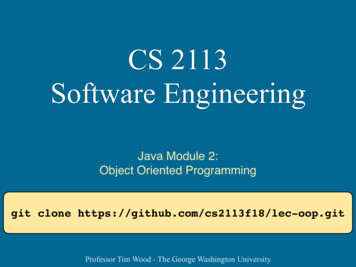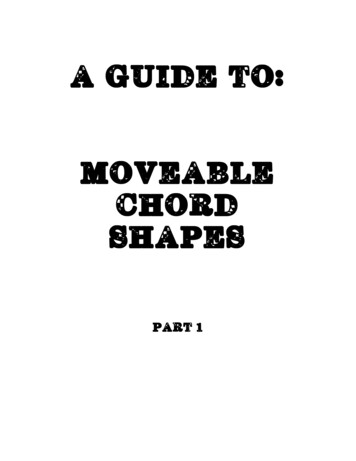
Transcription
January 2009Preprint typeset in JHEP style - HYPER VERSIONString TheoryUniversity of Cambridge Part III Mathematical TriposDr David TongDepartment of Applied Mathematics and Theoretical Physics,Centre for Mathematical Sciences,Wilberforce Road,Cambridge, CB3 OWA, d.tong@damtp.cam.ac.uk–1–
Recommended Books and Resources J. Polchinski, String TheoryThis two volume work is the standard introduction to the subject. Our lectures willmore or less follow the path laid down in volume one covering the bosonic string. Thebook contains explanations and descriptions of many details that have been deliberately(and, I suspect, at times inadvertently) swept under a very large rug in these lectures.Volume two covers the superstring. M. Green, J. Schwarz and E. Witten, Superstring TheoryAnother two volume set. It is now over 20 years old and takes a slightly old-fashionedroute through the subject, with no explicit mention of conformal field theory. However, it does contain much good material and the explanations are uniformly excellent.Volume one is most relevant for these lectures. B. Zwiebach, A First Course in String TheoryThis book grew out of a course given to undergraduates who had no previous exposureto general relativity or quantum field theory. It has wonderful pedagogical discussionsof the basics of lightcone quantization. More surprisingly, it also has some very cleardescriptions of several advanced topics, even though it misses out all the bits in between. P. Di Francesco, P. Mathieu and D. Sénéchal, Conformal Field TheoryThis big yellow book is affectionately known as the yellow pages. It’s a great wayto learn conformal field theory. At first glance, it comes across as slightly dauntingbecause it’s big. (And yellow). But you soon realise that it’s big because it starts atthe beginning and provides detailed explanations at every step. The material necessaryfor this course can be found in chapters 5 and 6.Further References: “String Theory and M-Theory” by Becker, Becker and Schwarzand “String Theory in a Nutshell” (it’s a big nutshell) by Kiritsis both deal with thebosonic string fairly quickly, but include more advanced topics that may be of interest.The book “D-Branes” by Johnson has lively and clear discussions about the many joysof D-branes. Links to several excellent online resources, including video lectures byShiraz Minwalla, are listed on the course webpage.
Contents0. Introduction0.1 Quantum Gravity131. The Relativistic String1.1 The Relativistic Point Particle1.1.1 Quantization1.1.2 Ein Einbein1.2 The Nambu-Goto Action1.2.1 Symmetries of the Nambu-Goto Action1.2.2 Equations of Motion1.3 The Polyakov Action1.3.1 Symmetries of the Polyakov Action1.3.2 Fixing a Gauge1.4 Mode Expansions1.4.1 The Constraints Revisited99111314171818202225262. The Quantum String2.1 A Lightning Look at Covariant Quantization2.1.1 Ghosts2.1.2 Constraints2.2 Lightcone Quantization2.2.1 Lightcone Gauge2.2.2 Quantization2.3 The String Spectrum2.3.1 The Tachyon2.3.2 The First Excited States2.3.3 Higher Excited States2.4 Lorentz Invariance Revisited2.5 A Nod to the Superstring282830303233364040414546483. Open Strings and D-Branes3.1 Quantization3.1.1 The Ground State3.1.2 First Excited States: A World of Light50535455–1–
3.1.3 Higher Excited States and Regge Trajectories3.1.4 Another Nod to the SuperstringBrane Dynamics: The Dirac ActionMultiple Branes: A World of Glue565657594. Introducing Conformal Field Theory4.0.1 Euclidean Space4.0.2 The Holomorphy of Conformal Transformations4.1 Classical Aspects4.1.1 The Stress-Energy Tensor4.1.2 Noether Currents4.1.3 An Example: The Free Scalar Field4.2 Quantum Aspects4.2.1 Operator Product Expansion4.2.2 Ward Identities4.2.3 Primary Operators4.3 An Example: The Free Scalar Field4.3.1 The Propagator4.3.2 An Aside: No Goldstone Bosons in Two Dimensions4.3.3 The Stress-Energy Tensor and Primary Operators4.4 The Central Charge4.4.1 c is for Casimir4.4.2 The Weyl Anomaly4.4.3 c is for Cardy4.4.4 c has a Theorem4.5 The Virasoro Algebra4.5.1 Radial Quantization4.5.2 The Virasoro Algebra4.5.3 Representations of the Virasoro Algebra4.5.4 Consequences of Unitarity4.6 The State-Operator Map4.6.1 Some Simple Consequences4.6.2 Our Favourite Example: The Free Scalar Field4.7 Brief Comments on Conformal Field Theories with 9292949698991011021055. The Polyakov Path Integral and Ghosts5.1 The Path Integral5.1.1 The Faddeev-Popov Method1081081093.23.3–2–
5.25.35.45.1.2 The Faddeev-Popov Determinant5.1.3 GhostsThe Ghost CFTThe Critical “Dimension” of String Theory5.3.1 The Usual Nod to the Superstring5.3.2 An Aside: Non-Critical StringsStates and Vertex Operators5.4.1 An Example: Closed Strings in Flat Space5.4.2 An Example: Open Strings in Flat Space5.4.3 More General CFTs1121131141171181191201221231246. String Interactions6.1 What to Compute?6.1.1 Summing Over Topologies6.2 Closed String Amplitudes at Tree Level6.2.1 Remnant Gauge Symmetry: SL(2,C)6.2.2 The Virasoro-Shapiro Amplitude6.2.3 Lessons to Learn6.3 Open String Scattering6.3.1 The Veneziano Amplitude6.3.2 The Tension of D-Branes6.4 One-Loop Amplitudes6.4.1 The Moduli Space of the Torus6.4.2 The One-Loop Partition Function6.4.3 Interpreting the String Partition Function6.4.4 So is String Theory Finite?6.4.5 Beyond Perturbation Theory?6.5 Appendix: Games with Integrals and Gamma 91521531547. Low Energy Effective Actions7.1 Einstein’s Equations7.1.1 The Beta Function7.1.2 Ricci Flow7.2 Other Couplings7.2.1 Charged Strings and the B field7.2.2 The Dilaton7.2.3 Beta Functions7.3 The Low-Energy Effective Action157158159163163163165167167–3–
7.47.57.67.77.3.1 String Frame and Einstein Frame7.3.2 Corrections to Einstein’s Equations7.3.3 Nodding Once More to the SuperstringSome Simple Solutions7.4.1 Compactifications7.4.2 The String Itself7.4.3 Magnetic Branes7.4.4 Moving Away from the Critical Dimension7.4.5 The Elephant in the Room: The TachyonD-Branes Revisited: Background Gauge Fields7.5.1 The Beta Function7.5.2 The Born-Infeld ActionThe DBI Action7.6.1 Coupling to Closed String FieldsThe Yang-Mills Action7.7.1 D-Branes in Type II Superstring Theories8. Compactification and T-Duality8.1 The View from Spacetime8.1.1 Moving around the Circle8.2 The View from the Worldsheet8.2.1 Massless States8.2.2 Charged Fields8.2.3 Enhanced Gauge Symmetry8.3 Why Big Circles are the Same as Small Circles8.3.1 A Path Integral Derivation of T-Duality8.3.2 T-Duality for Open Strings8.3.3 T-Duality for Superstrings8.3.4 Mirror Symmetry8.4 09
AcknowledgementsThese lectures are aimed at beginning graduate students. They assume a workingknowledge of quantum field theory and general relativity. The lectures were given overone semester and are based broadly on Volume one of the book by Joe Polchinski. Iinherited the course from Michael Green whose notes were extremely useful. I alsobenefited enormously from the insightful and entertaining video lectures by ShirazMinwalla.I’m grateful to Anirban Basu, Niklas Beisert, Joe Bhaseen, Diego Correa, Nick Dorey,Michael Green, Anshuman Maharana, Malcolm Perry and Martin Schnabl for discussions and help with various aspects of these notes. I’m also grateful to the students,especially Carlos Guedes, for their excellent questions and superhuman typo-spottingabilities. Finally, my thanks to Alex Considine for infinite patience and understandingover the weeks these notes were written. I am supported by the Royal Society.–5–
0. IntroductionString theory is an ambitious project. It purports to be an all-encompassing theoryof the universe, unifying the forces of Nature, including gravity, in a single quantummechanical framework.The premise of string theory is that, at the fundamental level, matter does not consistof point-particles but rather of tiny loops of string. From this slightly absurd beginning,the laws of physics emerge. General relativity, electromagnetism and Yang-Mills gaugetheories all appear in a surprising fashion. However, they come with baggage. Stringtheory gives rise to a host of other ingredients, most strikingly extra spatial dimensionsof the universe beyond the three that we have observed. The purpose of this course isto understand these statements in detail.These lectures differ from most other courses that you will take in a physics degree.String theory is speculative science. There is no experimental evidence that stringtheory is the correct description of our world and scant hope that hard evidence willarise in the near future. Moreover, string theory is very much a work in progress andcertain aspects of the theory are far from understood. Unresolved issues abound andit seems likely that the final formulation has yet to be written. For these reasons, I’llbegin this introduction by suggesting some answers to the question: Why study stringtheory?Reason 1. String theory is a theory of quantum gravityString theory unifies Einstein’s theory of general relativity with quantum mechanics.Moreover, it does so in a manner that retains the explicit connection with both quantumtheory and the low-energy description of spacetime.But quantum gravity contains many puzzles, both technical and conceptual. Whatdoes spacetime look like at the shortest distance scales? How can we understandphysics if the causal structure fluctuates quantum mechanically? Is the big bang truelythe beginning of time? Do singularities that arise in black holes really signify the endof time? What is the microscopic origin of black hole entropy and what is it tellingus? What is the resolution to the information paradox? Some of these issues will bereviewed later in this introduction.Whether or not string theory is the true description of reality, it offers a frameworkin which one can begin to explore these issues. For some questions, string theoryhas given very impressive and compelling answers. For others, string theory has beenalmost silent.–1–
Reason 2. String theory may be the theory of quantum gravityWith broad brush, string theory looks like an extremely good candidate to describe thereal world. At low-energies it naturally gives rise to general relativity, gauge theories,scalar fields and chiral fermions. In other words, it contains all the ingredients thatmake up our universe. It also gives the only presently credible explanation for the valueof the cosmological constant although, in fairness, I should add that the explanation isso distasteful to some that the community is rather amusingly split between whetherthis is a good thing or a bad thing. Moreover, string theory incorporates several ideaswhich do not yet have experimental evidence but which are considered to be likelycandidates for physics beyond the standard model. Prime examples are supersymmetryand axions.However, while the broad brush picture looks good, the finer details have yet tobe painted. String theory does not provide unique predictions for low-energy physicsbut instead offers a bewildering array of possibilities, mostly dependent on what ishidden in those extra dimensions. Partly, this problem is inherent to any theory ofquantum gravity: as we’ll review shortly, it’s a long way down from the Planck scaleto the domestic energy scales explored at the LHC. Using quantum gravity to extractpredictions for particle physics is akin to using QCD to extract predictions for howcoffee makers work. But the mere fact that it’s hard is little comfort if we’re lookingfor convincing evidence that string theory describes the world in which we live.While string theory cannot at present offer falsifiable predictions, it has nonethelessinspired new and imaginative proposals for solving outstanding problems in particlephysics and cosmology. There are scenarios in which string theory might reveal itselfin forthcoming experiments. Perhaps we’ll find extra dimensions at the LHC, perhapswe’ll see a network of fundamental strings stretched across the sky, or perhaps we’lldetect some feature of non-Gaussianity in the CMB that is characteristic of D-branesat work during inflation. My personal feeling however is that each of these is a longshot and we may not know whether string theory is right or wrong within our lifetimes.Of course, the history of physics is littered with naysayers, wrongly suggesting thatvarious theories will never be testable. With luck, I’ll be one of them.Reason 3. String theory provides new perspectives on gauge theoriesString theory was born from attempts to understand the strong force. Almost fortyyears later, this remains one of the prime motivations for the subject. String theoryprovides tools with which to analyze down-to-earth aspects of quantum field theorythat are far removed from high-falutin’ ideas about gravity and black holes.–2–
Of immediate relevance to this course are the pedagogical reasons to invest time instring theory. At heart, it is the study of conformal field theory and gauge symmetry.The techniques that we’ll learn are not isolated to string theory, but apply to countlesssystems which have direct application to real world physics.On a deeper level, string theory provides new and very surprising methods to understand aspects of quantum gauge theories. Of these, the most startling is the AdS/CFTcorrespondence, first conjectured by Juan Maldacena, which gives a relationship between strongly coupled quantum field theories and gravity in higher dimensions. Theseideas have been applied in areas ranging from nuclear physics to condensed matterphysics and have provided qualitative (and arguably quantitative) insights into stronglycoupled phenomena.Reason 4. String theory provides new results in mathematicsFor the past 250 years, the close relationship between mathematics and physics hasbeen almost a one-way street: physicists borrowed many things from mathematiciansbut, with a few noticeable exceptions, gave little back. In recent times, that haschanged. Ideas and techniques from string theory and quantum field theory have beenemployed to give new “proofs” and, perhaps more importantly, suggest new directionsand insights in mathematics. The most well known of these is mirror symmetry, arelationship between topologically different Calabi-Yau manifolds.The four reasons described above also crudely characterize the string theory community: there are “relativists” and “phenomenologists” and “field theorists” and “mathematicians”. Of course, the lines between these different sub-disciplines are not fixedand one of the great attractions of string theory is its ability to bring together peopleworking in different areas — from cosmology to condensed matter to pure mathematics— and provide a framework in which they can profitably communicate. In my opinion,it is this cross-fertilization between fields which is the greatest strength of string theory.0.1 Quantum GravityThis is a starter course in string theory. Our focus will be on the perturbative approachto the bosonic string and, in particular, why this gives a consistent theory of quantumgravity. Before we leap into this, it is probably best to say a few words about quantumgravity itself. Like why it’s hard. And why it’s important. (And why it’s not).The Einstein Hilbert action is given bySEH1 16πGNZ–3– d4 x gR
Newton’s constant GN can be written as8πGN cMpl2Throughout these lectures we work in units with c 1. The Planck mass Mpldefines an energy scaleMpl 2 1018 GeV .(This is sometimes referred to as the reducedPlanck mass, to distinguish it from thepscale without the factor of 8π, namely 1/GN 1 1019 GeV).There are a couple of simple lessons that we can already take from this. The first isthat the relevant coupling in the quantum theory is 1/Mpl . To see that this is indeedthe case from the perspective of the action, we consider small perturbations around flatMinkowski space,gµν ηµν 1hµνMplThe factor of 1/Mpl is there to ensure that when we expand out the Einstein-Hilbertaction, the kinetic term for h is canonically normalized, meaning that it comes with nopowers of Mpl . This then gives the kind of theory that you met in your first course onquantum field theory, albeit with an infinite series of interaction terms,Z11h ( h)2 2 h2 ( h)2 . . .SEH d4 x ( h)2 MplMplEach of these terms is schematic: if you were to do this explicitly, you would find amess of indices contracted in different ways. We see that the interactions are suppressedby powers of Mpl . This means that quantum perturbation theory is an expansion inthe dimensionless ratio E 2 /Mpl2 , where E is the energy associated to the process ofinterest. We learn that gravity is weak, and therefore under control, at low-energies.But gravitational interactions become strong as the energy involved approaches thePlanck scale. In the language of the renormalization group, couplings of this type areknown as irrelevant.The second lesson to take away is that the Planck scale Mpl is very very large. TheLHC will probe the electroweak scale, MEW 103 GeV. The ratio is MEW /Mpl 10 15 .For this reason, quantum gravity will not affect your daily life, even if your daily lifeinvolves the study of the most extreme observable conditions in the universe.–4–
Gravity is Non-RenormalizableQuantum field theories with irrelevant couplings are typically ill-behaved at highenergies, rendering the theory ill-defined. Gravity is no exception. Theories of thistype are called non-renormalizable, which means that the divergences that appear inthe Feynman diagram expansion cannot be absorbed by a finite number of counterterms. In pure Einstein gravity, the symmetries of the theory are enough to ensure thatthe one-loop S-matrix is finite. The first divergence occurs at two-loops and requiresthe introduction of a counterterm of the form,Z1 1Γ Mpl4 d4 x g Rµνρσ Rρσλκ Rλκµνwith 4 D. All indications point towards the fact that this is the first in an infinitenumber of necessary counterterms.Coupling gravity to matter requires an interaction term of the form,ZSint d4 x1hµν T µν O(h2 )MplThis makes the situation marginally worse, with the first divergence now appearing at one-loop. The Feynman diagram in thefigure shows particle scattering through the exchange of two gravitons. When the momentum k running in the loop is large, thediagram is badly divergent: it scales as1Mpl4Z Figure 1:d4 kNon-renormalizable theories are commonplace in the history of physics, the most commonly cited example being Fermi’s theory of the weak interaction. The first thing to sayabout them is that they are far from useless! Non-renormalizable theories are typicallyviewed as effective field theories, valid only up to some energy scale Λ. One deals withthe divergences by simply admitting ignorance beyond this scale and treating Λ as aUV cut-off on any momentum integral. In this way, we get results which are valid to anaccuracy of E/Λ (perhaps raised to some power). In the case of thep weak interaction,Fermi’s theory accurately predicts physics up to an energy scale of 1/GF 100 GeV.In the case of quantum gravity, Einstein’s theory works to an accuracy of (E/Mpl )2 .–5–
However, non-renormalizable theories are typically unable to describe physics at theircut-off scale Λ or beyond. This is because they are missing the true ultra-violet degreesof freedom which tame the high-energy behaviour. In the case of the weak force, thesenew degrees of freedom are the W and Z bosons. We would like to know what missingdegrees of freedom are needed to complete gravity.SingularitiesOnly a particle physicist would phrase all questions about the universe in terms ofscattering amplitudes. In general relativity we typically think about the geometry asa whole, rather than bastardizing the Einstein-Hilbert action and discussing perturbations around flat space. In this language, the question of high-energy physics turns intoone of short distance physics. Classical general relativity is not to be trusted in regionswhere the curvature of spacetime approaches the Planck scale and ultimately becomessingular. A quantum theory of gravity should resolve these singularities.The question of spacetime singularities is morally equivalent to that of high-energyscattering. Both probe the ultra-violet nature of gravity. A spacetime geometry ismade of a coherent collection of gravitons, just as the electric and magnetic fields in alaser are made from a collection of photons. The short distance structure of spacetimeis governed – after Fourier transform – by high momentum gravitons. Understandingspacetime singularities and high-energy scattering are different sides of the same coin.There are two situations in general relativity where singularity theorems tell us thatthe curvature of spacetime gets large: at the big bang and in the center of a black hole.These provide two of the biggest challenges to any putative theory of quantum gravity.Gravity is SubtleIt is often said that general relativity contains the seeds of its own destruction. Thetheory is unable to predict physics at the Planck scale and freely admits to it. Problemssuch as non-renormalizability and singularities are, in a Rumsfeldian sense, knownunknowns. However, the full story is more complicated and subtle. On the one hand,the issue of non-renormalizability may not quite be the crisis that it first appears. Onthe other hand, some aspects of quantum gravity suggest that general relativity isn’tas honest about its own failings as is usually advertised. The theory hosts a number ofunknown unknowns, things that we didn’t even know that we didn’t know. We won’thave a whole lot to say about these issues in this course, but you should be aware ofthem. Here I mention only a few salient points.–6–
Firstly, there is a key difference between Fermi’s theory of the weak interaction andgravity. Fermi’s theorywas unable to provide predictions for any scattering processpat energies above 1/GF . In contrast, if we scatter two objects at extremely highenergies in gravity — say, at energies E Mpl — then we know exactly what willhappen: we form a big black hole. We don’t need quantum gravity to tell us this.Classical general relativity is sufficient. If we restrict attention to scattering, the crisisof non-renormalizability is not problematic at ultra-high energies. It’s troublesome onlywithin a window of energies around the Planck scale.Similar caveats hold for singularities. If you are foolish enough to jump into a blackhole, then you’re on your own: without a theory of quantum gravity, no one can tell youwhat fate lies in store at the singularity. Yet, if you are smart and stay outside of theblack hole, you’ll be hard pushed to see any effects of quantum gravity. This is becauseNature has conspired to hide Planck scale curvatures from our inquisitive eyes. In thecase of black holes this is achieved through cosmic censorship which is a conjecture inclassical general relativity that says singularities are hidden behind horizons. In thecase of the big bang, it is achieved through inflation, washing away any traces from thevery early universe. Nature appears to shield us from the effects of quantum gravity,whether in high-energy scattering or in singularities. I think it’s fair to say that no oneknows if this conspiracy is pointing at something deep, or is merely inconvenient forscientists trying to probe the Planck scale.While horizons may protect us from the worst excesses of singularities, they comewith problems of their own. These are the unknown unknowns: difficulties that arisewhen curvatures are small and general relativity says “trust me”. The entropy of blackholes and the associated paradox of information loss strongly suggest that local quantum field theory breaks down at macroscopic distance scales. Attempts to formulatequantum gravity in de Sitter space, or in the presence of eternal inflation, hint at similardifficulties. Ideas of holography, black hole complimentarity and the AdS/CFT correspondence all point towards non-local effects and the emergence of spacetime. These arethe deep puzzles of quantum gravity and their relationship to the ultra-violet propertiesof gravity is unclear.As a final thought, let me mention the one observation that has an outside chance ofbeing related to quantum gravity: the cosmological constant. With an energy scale ofΛ 10 3 eV it appears to have little to do with ultra-violet physics. If it does have itsorigins in a theory of quantum gravity, it must either be due to some subtle “unknownunknown”, or because it is explained away as an environmental quantity as in stringtheory.–7–
Is the Time Ripe?Our current understanding of physics, embodied in the standard model, is valid up toenergy scales of 103 GeV. This is 15 orders of magnitude away from the Planck scale.Why do we think the time is now ripe to tackle quantum gravity? Surely we are likethe ancient Greeks arguing about atomism. Why on earth do we believe that we’vedeveloped the right tools to even address the question?The honest answer, I think, is hubris.However, there is mild circumstantial evidencethat the framework of quantum field theory mighthold all the way to the Planck scale without anything very dramatic happening in between. Themain argument is unification. The three couplingconstants of Nature run logarithmically, meetingmiraculously at the GUT energy scale of 1015 GeV.Just slightly later, the fourth force of Nature, gravity, joins them. While not overwhelming, this doesprovide a hint that perhaps quantum field theoryFigure 2:can be taken seriously at these ridiculous scales.Historically I suspect this was what convinced large parts of the community that it wasok to speak about processes at 1018 GeV.Finally, perhaps the most compelling argument for studying physics at the Planckscale is that string theory does provide a consistent unified quantum theory of gravityand the other forces. Given that we have this theory sitting in our laps, it would befoolish not to explore its consequences. The purpose of these lecture notes is to beginthis journey.–8–
1. The Relativistic StringAll lecture courses on string theory start with a discussion of the point particle. Oursis no exception. We’ll take a flying tour through the physics of the relativistic pointparticle and extract a couple of important lessons that we’ll take with us as we moveonto string theory.1.1 The Relativistic Point ParticleWe want to write down the Lagrangian describing a relativistic particle of mass m.In anticipation of string theory, we’ll consider D-dimensional Minkowski space R1,D 1 .Throughout these notes, we work with signatureηµν diag( 1, 1, 1, . . . , 1)Note that this is the opposite signature to my quantum field theory notes.If we fix a frame with coordinates X µ (t, x) the action is simple:qZS m dt 1 x · x .(1.1)To see that this is correct we can compute the momentum p , conjugate to x, and theenergy E which is equal to the Hamiltonian,m x p p1 x · x ,E pm2 p 2 ,both of which should be familiar from courses on special relativity.Although the Lagrangian (1.1) is correct, it’s not fully satisfactory. The reason isthat time t and space x play very different roles in this Lagrangian. The position x isa dynamical degree of freedom. In contrast, time t is merely a parameter providing alabel for the position. Yet Lorentz transformations are supposed to mix up t and x andsuch symmetries are not completely obvious in (1.1). Can we find a new Lagrangianin which time and space are on equal footing?One possibility is to treat both time and space as labels. This leads us to theconcept of field theory. However, in this course we will be more interested in the otherpossibility: we will promote time to a dynamical degree of freedom. At first glance,this may appear odd: the number of degrees of freedom is one of the crudest ways wehave to characterize a system. We shouldn’t be able to add more degrees of freedom–9–
at will without fundamentally changing the system that we’re talking about. Anotherway of saying this is that the particle has the option to move in space, but it doesn’thave the option to move in time. It has to move in time. So we somehow need a wayto promote time to a degree of freedom without it really being a true dynamical degreeof freedom! How do we do this? The answer, as we will now show, is gauge symmetry.Consider the action,X0ZS mqdτ Ẋ µ Ẋ ν ηµν ,(1.2)where µ 0, . . . , D 1 and Ẋ µ dX µ /dτ . We’ve introduced anew parameter τ which labels the position along the worldline ofthe particle as shown by the dashed lines in the figure. This actionRhas a simple interpretation: it is just the proper time ds along theworldline.XFigure 3:Naively it looks as if we now have D physical degrees of freedom rather than D 1because, as promised, the time direction X 0 t is among our dynamical variables:X 0 X 0 (τ ). However, this is an illusion. To see why, we need to note that the action(1.2) has a very important property: reparameterization invariance. This means thatwe can pick a different parameter τ̃ on the worldline, related to τ by any monotonicfunctionτ̃ τ̃ (τ ) .Let’s check that the action is invariant under transformations of this type. The integration measure in the action changes as dτ dτ̃ dτ /dτ̃ . Meanwhile, the velocitieschange as dX µ /dτ (dX µ /dτ̃ ) (dτ̃ /dτ ). Putting this together, we see that the actioncan just as well be written in the τ̃ reparameterization,rZdX µ dX νS m dτ̃ ηµν .dτ̃ dτ̃The upshot of this is that not all D degrees of freedom X µ are physical. For example,suppose you find a solution to this system, so that you know how X 0 changes withτ and how X 1 changes with τ and so on. Not all of that information is mean
Reason 1. String theory is a theory of quantum gravity String theory uni es Einstein’s theory of general relativity with quantum mechanics. Moreover, it does so in a manner that retains the explicit connection with both quantum theory and the low-energy description of spacetime. But quantum










